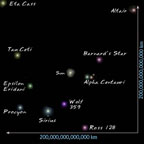
The Solar Neighborhood
About the Image

This image is a 2-D representation of some of the stars in the Solar Neighborhood. They are positioned in roughly the correct orientation with respect to the Sun. For a good three dimensional representation of the solar neighborhood, see the Atlas of the Universe site - the solar neighborhood to 12.5 light years and to 250 light years.
Distance Information
We've already learned the closest star to ours is 39,900,000,000,000 km (4.22 light years) away. The some of the other nearby stars are, in order:
| Proxima Centauri | 4.22 light years (ly) |
| Barnard's Star | 5.97 ly |
| Wolf 359 | 7.7 ly |
| Sirius A & B | 8.6 ly |
| Epsilon Eridani | 10.5 ly |
| Ross 128 | 10.8 ly |
| Procyon | 11.4 ly |
| Tau Ceti | 11.9 ly |
| Altair | 16.3 ly |
| Eta Cassiopeiae | 19 ly |
How Do We Calculate Distances of This Magnitude?
On the Nearest Stars page, we discussed the parallax method of finding the distances to the stars closest to us. We can use parallax to find the distances to the stars in the solar neighborhood as well.
Astronomers have been carefully measuring parallaxes for stars since 1838, and with remarkable precision. But it is painstakingly slow work with only a few thousand stars having well-measured parallaxes. In 1989, the European Space Agency (ESA) launched a satellite called Hipparcos to accurately measure the positions and motions of nearly 120,000 stars. It has also made these measurements for approximately another million or so stars with good, but lower precision. Hipparcos measurements increased the number of stars for which parallaxes are accurately measured by many thousands. The satellite was named Hipparcos from the acronym " HIgh Precision PARallax COllecting Satellite", which also honors the Byzantine mathematician Hipparchus.
Parallaxes give us distances to stars up to perhaps a few thousand light years. Beyond that distance, parallaxes are so small than they cannot be measured with contemporary instruments. Astronomers use more indirect methods beyond a few thousand light years. These methods are described in detail in most elementary astronomy text books, specifically George Abell's "Exploration of the Universe ", which can be found at local libraries. See also the Milky Way page for more information.
For more advanced information on finding distances to objects like stars, check out "The ABCs of Distances".
Why Are These Distances Important To Astronomers?
Knowing the distances to our stellar neighbors can help us learn more about the stellar neighborhood. Studying nearby stars can help us learn more about our own. Moreover, what if some of these nearby stars have their own solar systems?
Epsilon Eridani (at 10.5 light years away) is not only one of the closest solar-type stars, as of 2007, it is the closest star to us with a known planetary system. About 20 light years from us, is the red dwarf star Gliese 581. Its third planet appears to be the best example of a possible terrestrial extra solar planet which orbits close to the habitable zone of its star (also as of 2007)! A habitable zone is a region of space around a star where conditions are favorable (ie, not too hot, or too cold) for life as it can be found on Earth. (For more information on this, see the "Why Are These Distances Important To Astronomers?" section of the Solar System Information page.
The distances to the stars in our solar neighborhood will change over time, because the stars are not stationary, as we discussed on the Nearest Stars page. Astronomers call the movements of the stars "proper motion"; it is defined as the apparent angular motion of a star across the sky with respect to more distant stars. A typical proper motion for a star is ~0.1 arcseconds per year. The largest proper motion belongs to one of the stars nearest to us - Barnard's Star has a proper motion of 10.25 arcseconds per year.
This motion of the stars can alter the way constellations look from Earth. Here is a movie from the Ohio State Univerity showing the Big Dipper and how its shape has and will change between 100,000 BC and 100,000 AD.
Travel Time
It would take Voyager 1 330,700 years to arrive at Eta Cassiopeiae, at Voyager's rate of 17.3 km/s. Traveling at light speed, an impossibility due to Special Relativity, it would take 19 years to get there from Earth.


